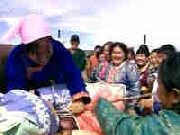 |
|
Preparing dowry
|
Prior to leaving, the bride's elders will dress the bridegroom in the handmade wedding clothes and put on a 1.6-meter-long belt around his waist, which means longevity according to Barag customs. Beside, tThey are also to handrm him with a bow and some arrows.
As the dawn breaks, the wedding procession will starts back ahead of the bridegroom to inform the family members of the glad tidings and wait for the bride's arrival of the bride.
Back at the bride's home, the family members, relatives and friends of the bride, having drunk the wedding wine, set to check the dowery and get ready to see the bride off. Having to part with her beloved parents and hometown, Nuo Min feels very sad; so does . And so is her mother, who bids farewell to her the daughter with tears in eyes, and spills some milk over the ground, praying a peaceful and fortunate life for her daughter.
In a traditional Barag wedding, the bride's escorting procession of the bride leave for the bridegroom's home on a team of horsebacks, constituting a horse team, in which the horses are all strong and sturdy horses, with respective characters in their hair colors. As a mMatching to such a the horse team, is a two-horse-driven wagon driven by two horses is used, which is for the senior or respectable peoplersons. Sometimes, a small two-wheeled carriage is also used to go with the horse team. Inside the wagon or carriage are numerous decorations, which also conveys the traditional culture and life as well as religious beliefs.
As the Hunlun Buir Grassland covers a vast area and the Barag people are sparsely scattered, sometimes, it takes a day or several days for the wedding procession to reach the bride's home. In modern times, however, the Barag people have begun to use cars for at their wedding day.
 |
|
Barag Grassland
|
As is thea custom, the bridegroom's family usually sends for a team to receive the escorting procession and serve wine and cigarettes to the distinguished guests. After that, the two teams will head off to the bridegroom's home, where people are waiting anxiously wait. Upon arrival, the escorting procession will circle the yurt clockwise for three times laps before and then dismounting by the side of the hitching post.
In accordance with Barag customs of marriage, the bride cannot enter the bridal chamber until the entire all the dowerydowry has been moved in. The most interesting is the custom of beating the pillow, when people fight to beat the bride's pillow with a stick. This signifies is meant to washing away the dust for the newlyweds so that they will stay loyal to each other. After a fit of buzzing and bustle and commotioning, the escorting people are invited into the yurt in the order of seniority.
Right after the wedding ceremony, the bride goes to the kitchen and sets to prepare milk-tea. It is a long-existing tradition for the bride to serve the milk-tea she first prepares after marriage to the guests, which not only shows her cooking abilities but also marks the beginning of her being a part of the family.
After the bride's milk-tea, it is time for the escorting procession to return start their way home. The bride's elders will usually make it a point of especially exhort ing the newlyweds to respect the elders, and love the young and to live in love and harmony. Then, the bridegroom's family members will toast and bid farewell to them. Afterwards, Following that, the quickest lad among the escorting procession will grab the silver bowl and ride away, who are to then be chased by the rider sent for by the bridegroom's part. Vying for the silver bowl is seen as a comparison and competition of skills and strength between the two families.
Among good wishes and farewells, the escorting procession set foot on their way back, while people gather ed at the bridegroom's family to give themselves over to dances and songs, as nd a the bonfire will stay burns ing until dawn.
Author: Jessie
